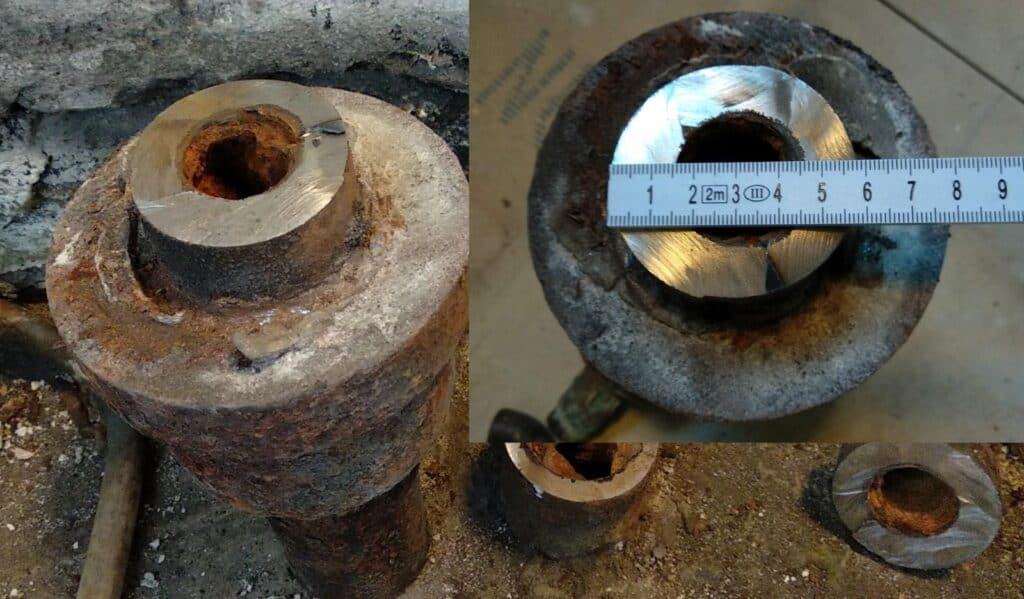Cast iron (CI) pipes are plumbing materials introduced in the 19th and early 20th centuries. These sturdy pipes were embraced for their thick walls and long lifespans. They indeed have long lifespans because centuries after their installation some are still in good working conditions while some are due for repair.

Whatever reason you may need to cut your CI pipe, it is essential to have the right tool and understand the process involved in cutting a CI pipe. CI pipes are stronger and thicker than any regular iron because they contain more carbon. A lot of tools have broken off or completely failed to cut through this iron.
The good news is that there are some chosen few capable of accomplishing the task. This article will explore How to cut through cast iron pipes with an Angle Grinder.
Can an Angle Grinder cut through a CI pipe?
An angle grinder is one of the most popular tools in maintenance and construction work. Designed with a very resilient material, an angle grinder can cut through different materials and they come in different sizes. Some of this material includes metal, iron, wood, and even concrete.
Check how to cut concrete with an angle grinder
We also have reviewed the best angle grinder for concrete. Check here.
An angle grinder can effectively cut through cast iron providing that it is fitted with the appropriate cutting disc. Generally, the most suitable blade for cutting cast iron is a diamond blade. This is because it offers great long-term benefits and high-quality performance.
What are the Tools and Preparation needed?
CI pipes are usually complicated when it comes to location as they may be in a tight space, detached, or even in a fixed open space. Irrespective of the position of your pipe, the following preparations and tools are necessary for safe and easy work.
- Appropriate disc and wheel: Depending on the location of your CI pipe, it is important to get suitable diamond discs and wheels that will not encumber your work.
- PPE items: these are the necessary items that will make sure you are protected from danger while cutting. Cutting cast iron with an angle grinder causes sparks to fly, some of these items will help protect you from harm.
- Safety goggles or face shield wrapped around the face
- A flame-resistant work cloth
- Nose mask to protect from debris or a respirator mask such as P2 or P3 respirator mask
- Steel-capped safety shoes
- Sturdy work gloves
- Duct tape: This will help to serve as resistance in order to reduce the sparks.
- Chalk: This can be used interchangeably or together with duct tape to mark the desired area that is to be cut.
- Clamps: In cases whereby your CI pipes are detached, use a normal workbench clamp to ensure that it is fixed to a position on the workbench. Riser clamps can be used to secure fixed CI pipes while cutting.
- Workbench: This is needed if the CI pipe is detached.
- Hammer and Chisel: To finish off the cutting.
The Procedure of Cutting CI Pipe with an Angle Grinder
Step 1: Safety Precautions
Ensure that all necessary PEPs are available and properly utilized. Clear the work area of cords, wires, or other materials not pertaining to the work at hand, and lastly, inform others around that you are working with a power tool for their safety.
Step 2: Attach Cutting wheels and discs
Before attaching the cutting disc, ensure that the angle grinder is unplugged. Carefully attach your wheel and disc. Ensure that your chosen wheel matches the size and speed of your angle grinder to avoid kickback. And before you start working double-check that the Revolution Per Minute (RPM) listed on your disc is equal to or greater than that of your angle grinder.
Step 3: Test run your Equipment
Always test your equipment the switch and the power source before any major work is done. Normally, when cutting through cast iron, there is bound to be vibrations. These vibrations together with the sound of the power tool can take you by surprise and lead to an accident if you have not tested the equipment beforehand.
Step 4: Mark the Pipe
Properly mark the section to be cut with chalk to allow for a more accurate cut. Some DIYers suggest duct tape could be used for marking the desired area because of its insulation properties that can help to reduce the spark ratio while cutting.
Step 5: Attach your clamp
It is important to safely secure the CI pipe in place whether by using a workbench vice or riser clamp depending on the situation.
Step 6: Start
First, connect the angle grinder to power and turn on the tool. While starting, ensure your arms are not awkward but properly positioned at a 90-degree angle. Carefully allow the angle grinder through a focused point of penetration. Be specific to avoid kickbacks.
Step 7: Maintain position
It is very important to maintain position while cutting. Ensure that there are no jagged cuts while you steadily make movements to deepen the cut. For thicker CI pipes, you may need to repeat penetration several times or remove the cutting wheel from the pipe and make another incision from the other side.
While removing the cutting wheel for thicker pipes, maintain a steady grip and do not tilt the angle grinder to prevent further jagged cuts. For a more deliberate finish, you can employ the use of a hammer to drive in a cold chisel into the CI pipe to break off loose edges.
Step 8: Finish cutting
After the pipe has dropped loose, allow the cutting disc to come to a halt before unplugging it from the power source.
Related Articles:
Best angle grinder wheel for cutting metal
Best 9-inch angle grinder reviews
Angle grinder vs rotary tool. What are the differences?
Last Updated on January 30, 2022 by John G. Anderson
Contents
